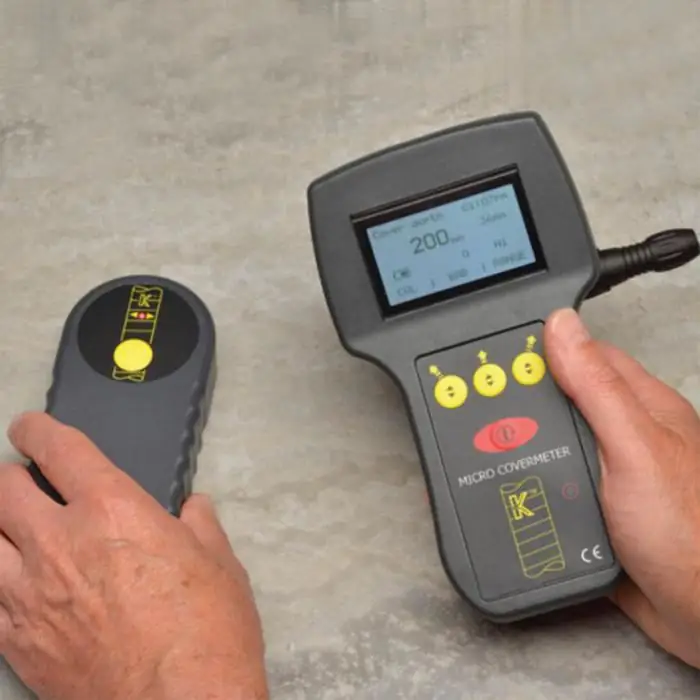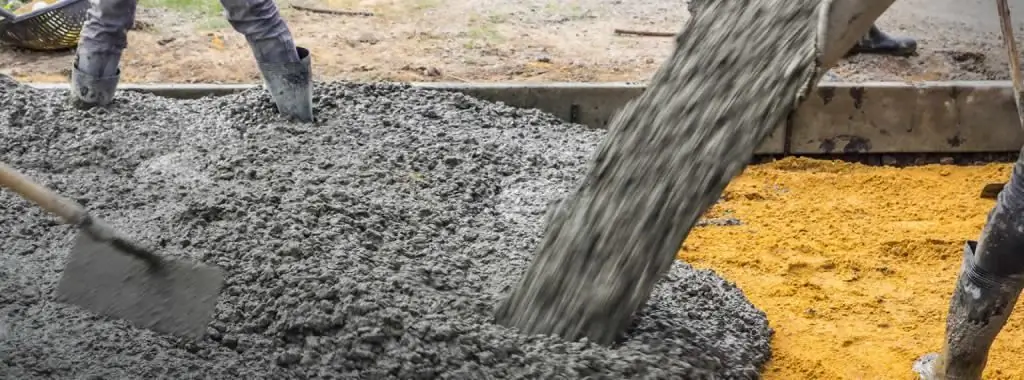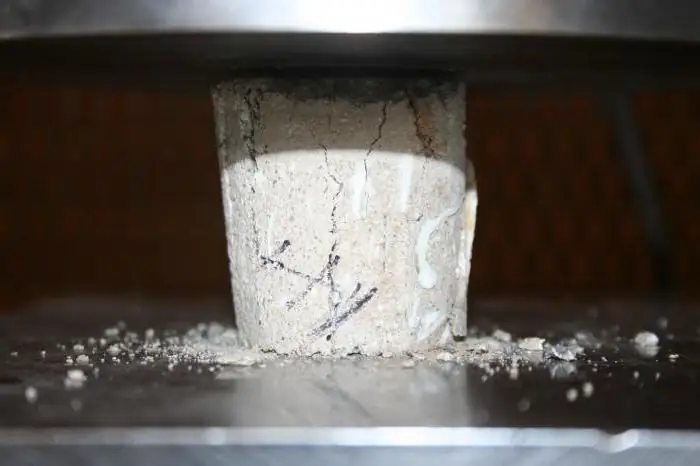2026 Author: Howard Calhoun | [email protected]. Last modified: 2025-01-24 13:10:43
When checking building structures, the determination of the strength of concrete is carried out to determine their state at the current time. Actual performance after the start of operation usually does not match the design parameters. They are directly affected by deformation loads and external factors. Different methods can be used during the diagnostic process.

Basic terms and definitions
Before considering the basic methods of monitoring and assessing the strength of concrete, it is recommended that you familiarize yourself with some concepts so that there are no questions in the future. All terms and definitions necessary for a clearer understanding of the topic are presented below.
- Concrete is a building material obtained artificially as a result of hardening of a mortar with a binder and fillers. Additional additives may be added to the mixture to achieve the best performance.
- Strength - the property of a hardened material to perceive mechanical loads without breakingwherein. During operation, structures are subjected to compression and tension, as well as other influences.
- Strength limit - the highest value of mechanical load applied, reduced directly to a certain cross-sectional area, after reaching which partial or complete destruction of the material occurs.
- Destructive methods for determining the strength of concrete - control of the listed parameters by taking control samples taken from the tested structure according to the points of GOST 28570.

- Non-destructive testing - checking the reliability of the basic properties of individual structural elements without dismantling. With this method, there is no need to decommission the object.
- Structural test area - a certain proportion of the volume, length or area of limited dimensions for which strength tests are carried out.
What is the control for?
When constructing residential buildings, industrial or commercial facilities, determining the strength of concrete avoids many negative consequences. The material is used at various stages of construction of buildings for various purposes. Depending on the type of structures, the requirements for mixtures can vary significantly. For example, for pouring foundations and walls, different grades of concrete are used, which are determined by strength characteristics.
The use of mixtures that do not meet the requirements may lead to the formation of cracks, deterioration of operationalqualities and premature failure of the structure. Research is often needed to determine whether a building can be further used for any purpose.
Concrete strength table: matching classes and grades
Mortars are divided into categories, which take into account various parameters. Usually, the strength of concrete in MPa is broken down into classes, indicated by a capital letter with a number. Such marking in a professional environment is considered the most convenient. For example, a B25 mortar will have a strength of 25 MPa.

As for the brand of concrete, it expresses an approximate value in kilograms per square centimeter. The designation is made according to the same principle. However, with the ratio of indicators, the normative coefficient of variation can be 13.5 percent.
For an example, it is proposed to familiarize yourself with a special table of concrete strength, which shows the correspondence between classes and grades of mixtures.
| Class | Brand | Strength, kgf/sq. m |
| B5 | M75 | 65 |
| B10 | M150 | 131 |
| B15 | M200 | 196 |
| B25 | M350 | 327 |
| B35 | M450 | 458 |
What influences durability?
During the course of chemical processes, the concrete mixture hardens. Water interacts with the binder. Under the influence of certain factors, the rate of a chemical reaction can be accelerated or slowed down. The final strength of concrete will depend to some extent on them.
Important factors include:
- initial binder activity;
- amount of water in the composition;
- compaction level;
- temperature and humidity;
- quality of mixing components.

An important role is played by the quality of the fillers used. Components with a fine fraction and clay substances lead to a decrease in strength. Large particles have better adhesion to the binder. Their use has a positive effect on strength indicators.
Classification of research methods
When determining the strength of concrete in building structures, difficult technical problems have to be solved. The development of theoretical and practical research in the field of quality control of building compositions has led to the emergence of numerous methods. Each of them has a specific scope, as well as its pros and cons.
If we take the method of influencing directly on the tested structure, then we can distinguish three main methods.
- Destructive. After the control operations, the sample cannot be used for its intended purpose.
- Non-destructive. The performance of the test does not affect the performance of the structure.
- Locally destructive. Refurbishment required after special events.
Inspection should be carried out only after a detailed acquaintance with the design and technical documentation. Having received certain information about the composition used and the manufacturing technology of the structure, you can begin work to determine the strength properties.

What factors determine the choice of method?
To find out the tensile strength of concrete, you must first decide on the research methodology. Her choice is influenced by the following factors:
- state of building mix;
- accessibility of test sites;
- amount of information collected;
- presence or absence of heterogeneous layers in the structure.
Despite the variety of methods, the results obtained by destructive methods are the most reliable, since the tests measure the desired indicator - the force applied during compression. In addition, a sample taken directly from the body of the structure, and not the upper part, is carefully studied.
Destructive control methods
The essence of the methods lies in the study of samples obtained by drilling or sawing out of the finished structure. They are subjected to a static load with a gradual increase in growth rate. As a result, it is possible to calculate the stresses under the applied forces.
The dimensions and shape of the samples taken depend on the type of testing being carried out. They must meet the requirements of GOST 10180.
| Research method | Shape of test specimens | Element sizes in millimeters |
| Determination of concrete tensile and compressive strengths | Cube | The length of the edges of the figure can be 100, 150, 200 or 300 mm |
| Cylinder | For research, a sample is taken two diameters high, one of which can have the same dimensions as the edges of the cube. | |
| Checking strength indicators for axial tension | Prism having a square section | The dimensions of the element to be tested can be: 200 x 200 x 800, 100 x 100 x 400 or 200 x 200 x 800mm. |
| Cylinder | Samples of the same size are taken during testing as in the case above. | |
| Determination of tensile strength in bending and splitting | Prism having a square section | During the work samples of the following sizes are taken: 200 x 200 x 800, 100 x 100 x 400 and 150 x 150 x 600 mm. |
To determine the strength of concrete, its samples are collected by drilling or sawing out individual parts.
- Seats are assigned afterpreliminary inspection. The design test area should be some distance from joints and edges.
- The remaining grooves after sampling are walled up with fine-grained concrete.
- In the process of drilling or sawing, diamond saw blades, special hole saws or suitable carbide tools are used.
- Sampling areas should be free of reinforcement. If this option cannot be implemented, then a piece of concrete with metal bars with a cross section of up to 16 mm is taken for samples with dimensions greater than 10 cm.
- The presence of reinforcement is unacceptable in studies of axial tension and compression. This negatively affects the final performance. In addition, rods should not be present in prism-shaped specimens in flexural tensile tests.
- Places for extracting samples, their number, as well as sizes are determined by the rules for controlling the strength of concrete, taking into account the points of GOST 18105.
Each piece taken is marked and described in the protocol. After that, it is carefully prepared for further testing. All samples must have a special scheme that clearly reflects the orientation of the parts directly in the design.

Mechanical non-destructive testing
This method is based on calibration dependencies. They are based on indirect characteristics. These include:
- indicators of the rebound of the striker directly from the concrete surface;
- percussion energy parametersimpulse;
- sizes of prints left as a result of mechanical impact;
- stress leading to local breakage at breakaway;
- force when breaking on a structure edge.
The rules for controlling the strength of concrete propose to use a certain set of measuring devices during testing: a caliper, an angular scale, a clock indicator and some other tools. The number of tests carried out and the distances between the working areas are given in the table.
| Applied research method | Number of events held | Distance in millimeters | |
| From the edges of the structure | Between work areas | ||
| Rib chipping | 2 | - | 200 |
| Plastic deformation | 5 | 50 | 30 |
| Separation | 1 | 50 | Double disc diameter |
| Elastic rebound | 5 | 50 | 30 |
| Shock Impulse | 10 | 50 | 15 |
| Tear-off with chipping | 1 | 150 | Digging depth,multiplied by 5 |
The above activities should be carried out on a concrete structure site with a total area of 100-600 square meters. see After the main tests have been carried out, the data are entered in a special log to establish calibration dependencies between indirect characteristics and strength indicators of the hardened mortar.

Non-destructive testing by physical methods of influence
The category of such methods includes technologies of acoustic impact and penetrating radiation. They provide an opportunity to judge the qualitative characteristics of the structure by the internal structure, since the propagation velocity of waves of elastic vibrations is measured directly through the material being tested.
The most commonly used device for determining the strength of concrete is the ultrasonic method. It allows you to take readings without exerting a mechanical impact on the structure. It measures the speed at which ultrasonic waves pass through a layer of concrete. With a through study, the sensors can be located on both sides, and with a superficial one, on one side.
Control using ultrasound is considered the most informative and quite simple. It allows not only to evaluate the strength parameters, but also to find possible defects inside the layers. The device used has several operating modes, which are presented in the table.
| Mode | Description |
| Calibration | Allows you to adapt the device to the characteristics of concrete. Shear waves are measured inside the hardened mixture, important parameters are determined, which are necessary for taking qualitative images of the structure of the array. |
| Overview | Gives you the opportunity to quickly study the internal structure of the structure. Thickness is measured, defects or objects in the array (fittings, pipes, cables) are detected. |
| Collection | Ultrasound data collected. Recording is done in various positions. Scanning is carried out in the form of a strip (or a special tape). |
| View | Used to analyze data over a long period of time. In this case, all types of images are present on the screen. They can be displayed one by one or all at once. |
The ultrasonic concrete strength tester allows multiple tests to be carried out repeatedly, constantly monitoring the change in parameters. The disadvantage is the error in the ratio of acoustic characteristics with the basic parameters.
About the hardening of building mixtures based on cement
There is a direct dependence of the strength of concrete on temperature during the curing process. Normal conditions are considered to be a mode from 15 to 20 degrees. As the temperature decreases, the increase in strength slows down. When frozen, hardening will occur if special additives have been added to the composition.
Raising the temperature speeds up the curing process, especially if the humidity is sufficient. However, heating more than 85 degrees is contraindicated, since it is difficult to protect the concrete mixture from drying out. The solidification process can be stimulated in two ways. The first of these is to use the internal heat, and the second is to use the external heat.
On the analysis of possible problems in determining strength
When using an ultrasonic concrete strength meter, special attention must be paid to establishing calibration dependencies. Without them, the data obtained cannot be considered evidence. To obtain more accurate results, you will have to take into account the amount and composition of the filler, the level of compaction, cement consumption and much more.
Recommended:
Staff loy alty is a correct, sincere and respectful attitude towards management and employees. Formation, evaluation and methods of increasing loy alty

This article will tell you in detail what is staff loy alty in an organization, how to determine the level of loy alty and what are the ways to increase it. And also after reading you can find out the features of the influence of loy alty factors on the work of the company
Concrete strength meters. Concrete testing methods

When constructing buildings and structures, it is very important to monitor the strength of concrete. For this, special devices are used. Measurement parameters can vary quite a lot
Concrete strength curing schedule: features, types, technology and key indicators

Concrete solution for a certain time after pouring will acquire the desired performance properties. This time interval is called the holding period, after which a protective layer can be applied
How to find your life's work: practical methods, tips and secrets of self-determination. Setting and achieving a goal

The main obstacle that prevents you from finding the main business of life is the psychological attitudes received in childhood. The unformed children's brain perceives everything it hears and builds patterns of behavior from this, which then pass into adulthood. Therefore, it turns out that many, even successful people, constantly experience the feeling that they are in the wrong place and do not what they would like to do
Concrete mix: properties, composition, types, grades of concrete, characteristics, compliance with GOST standards and application

Among the main properties of the concrete mixture, which is also called hydrotechnical concrete, it is necessary to highlight the increased water resistance. Buildings are being built from this material to be used in swampy areas or in regions that are prone to flooding

